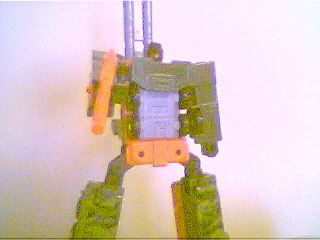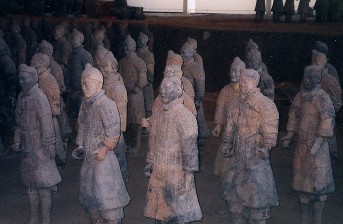Heinrich Wofflin
- He is said to be the father of Asian Art history. It was his "no objective vision" statement that changed the study forever.
Ludwig Bachhofer
- Student to Heinrich Wofflin, Bachhofer was able to solve the so-called "reading problem" by applying his teaching.
Max Loehr
- Loehr was a student to Bachhofer who developed an intracate system for identifying and analyzing Chinese bronzes from different dynasties.
Bernard Karlgren
- Bernard Karlgren was Max Loehr's contemporary who disagreed with him on his approach to analyzing Chinese bronzes.
Harrie Vanderstappen
- He too was a student of Bachhofer. However unlike Loehr, his study of Chinese bronzes had more to do with the tense vs flabby ways that bronze makers have used throughout these dynasties.
Mircea Eliade
- He wasn't an art historian but Eliade's studies on society helped Vanderstappen to develop his ideas.
Martin Powers
- He was a student of Vanderstappen who equated the possesion of Chinese bronze with a certain degree of power.
- He is said to be the father of Asian Art history. It was his "no objective vision" statement that changed the study forever.
Ideas They Raised
"No Objective Vision"
This idea was first proposed by Heinrich Wofflin. What Wofflin meant by this statement was that we as people may see something but we all don't see that thing the same way. This was important to Asian art historians because it helped them to solve the reading problem.Reading Problem
The problem here was that Asian art historians wanted to learn more about Asian art, but most if not all of them weren't fluent in the Asian languages, which were very difficult to learn in a short time. When Ludwig Bachhofer attepted to tackle this problem, he used Wofflin's idea of "no objective vision." He came to the conclusion that we see all things differently and that includes Asian art. It isn't necessary to know the language excactly, one can gain knowledge of a culture based on studying their art.Chinese Bronze Analysis
Many scholars have tried to study the bronze art of China. These people include Max Loehr, Bernard Karlgren, Harrie Vanderstappen, and Martin Powers. Each one had their own way to do it, and each one was right in their own respect.The Loehr System
Shang Dynasty- Architectonic shape, band of threadlike linear decoration.
- Architectonic shape, band of calligraphic linear decoration.
- Architectonic shape, overall decoration.
- Architectonic shape, image(tao-tieh)/ground(leiweh) distinction.
- Architectonic shape, image is plastic.
- Interflowing shape.
Karlgren's idea
Karlgren disagreed with Loehr on the basis of image. He believed that the image of tao-tieh began in stage 1 and then developed into a meaningless decoration at the later end of the dynasty. However, both scholars had different ideas of the word "image" which is a real life example of how dual interpretation can cause disagreement. Loehr's "image" meant a tao-tieh that was no longer equated with a real bronze god, whereas Karlgren's "image" meant a tao-tieh that was equated to a real bronze god. Both scholars mixed the wording up so they disagreed, but they are both right in their own respects.Tense vs Flabby
This idea was developed from Harrie Vanderstappen when he analyzed the way that Chinese bronzes were made throughout the Shang and Zhou Dynasties. This relates to Eliade's idea of ritual vs knowledge. Vanderstappen is basically saying that in the beginning when Chinese bronze makers believed that a bronze god was watching them make the bronze, they felt obligated to make the bronze as carefully as possible. This is the tense aspect of the process. Later, bronze makers have become so accustomed to making bronzes that they feel more at ease in their craft. In other words, the bronze god was not as real to them as it used to be, so they believe they can make a bronze any old how. This is the flabby aspect of the process.Ritual vs Knowledge
This idea by Mircea Eliade was based upon sociteties. When knowledge of a craft is limited, one has to rely on ritual all that much more. An example of this is trying to transform an Autobot for the first time. One normally can't do it without an instruction manual. But after performing that ritual a couple of times, it becomes common knowledge and one doesn't have to rely on it again. That is to say, knowledge and ritual are inversely proportional to one another. The more knowledge you have, the less ritual you need.Dual Interpretation
As opposed to single interpretation when one thing means another thing, dual interpretation means that one thing can equal many different things. Single interpretation would mean that an image only had one connotation, a picture and nothing more. But dual interpretation can give various definitions for the word image.Intellectual Development
The idea that tracks the development of something in terms of building up upon an earlier stage of development. You can't have one stage without a stage before to be based upon.Historical Development
This idea bases development upon a step by step basis. Which basically means that in one time something was done in a certain way, but in another time something was done in a differnt way.
Example:


Historical
In the 1980's, Transformers© were made like Mega Octane (left). Now they are made like Sideburn (right).Intellectual
In the 1980's, Transformers© were made like Mega Octane (left). But after various Transformers© that Hasbro and Takara have made over the years, they have developed Transformers© like Sideburn (right).The Importation of Buddhism to China
The Chinese had full knowledge of the Indian religion of Buddhism since the beginning of the first century AD, and have had knowledge of it for abut 400 years. During the Han Dynasty of China, the people's religions were Taoism and Confucianism. These two religions made it pretty easy for Buddhism to diffuse into China after the Han Dynasty fell. Taoism taught the Li of Li or the Principle of Principles. There were various beliefs in this religion, including the belief that one could fly if one was full of the breath of life. Confucianism was the other Chinese religion which taught the Li of Chi or the Principle of Manifestation. Confucianism teaches that all is well if everyone is where they need to be in life. e.g. This man's a president, this one is a citizen. It also taught that expansion was a good thing. This influenced the spead of Buddhism because during the Han Dynasty, China was really big on expanding its territory. Once the Han fell people began to question this belief and thusly turned to something else. This something else was Buddhism which believed in prana being the breath of life. This was something the Taoists agreed upon. Since the Confucian principle of expansion failed them, Chinese saw Buddhism to be an acceptable substitute.Chinese Buddhist Sculpture
When China imported Buddhism it also imported its Buddha sculpture. Chinese Buddhists made their own adaptations of the Buddha sculpture from 400-600 AD and eventually the sculpture became the style that they always seem to fall back to.- 400 Round & bulgy head/square shoulders/assymmetric drapery that shows the body
- 450 Elongated head/sloped shoulders/symmetric drapery that covers the body
- 500 Elongated head/sloped shoulders/Christmas tree-like drapery
- 518 Incised line moves up/Christmas tree-like drapery
- 525 Up & down fold drapery/thick & thin shadow in drapery/Christmas tree-like drapery
- 535 Up & down fold drapery/Christmas tree drapery moves down to the bottom
- 543 Shadows cast on the Buddha separate it from the background/Christmas tree drapery diappears
- 550-60 The background becomes perferated like swiss cheese
- 600 The Buddha befomes free standing or apart from the background
Chinese Painting
Throughout the history of Chinese painting, they have stayed consistent to Hsieh Ho's Six Laws of Painting.- Life's Breath= create's movement
- Bone Method- the proper way to move the brush
- Realism
- Color
- Copy
- Composition
| Dynasty | Change in space | Change in style | Examples |
|---|---|---|---|
| Han | There were figures in different cells at this time but the rest of the painting was empty space. | The paintings were mostly decorative |
|
| T'ang | In this time space is represented by more cells. Groups of figures occupy each cell while empty space fills all other parts. | Representational painting Objective: Realistic, nature above style |
|
| N. Sung | During this time these cells were taken up by monumental landscape. Space was represented by the area between the foreground, middleground, and background. The further the background or the closer the foreground was, the more space was created. | Representational painting Objective: Realistic, nature above style |
|
| S. Sung Yuan Ming | Bird and Flower style of painting |
|
Painting Schools
| School | Types of Painters | Dynasty |
|---|---|---|
| Zhe School | Court painters (professional) | Sung |
| Wu School | Literati painters | Yuan |
Works, Relics, and Places
Anyang
 This is the capital of the Shang Dynasty. A tomb was found at this capital complete with Chinese bronzes and the remains of human sacrifices.
This is the capital of the Shang Dynasty. A tomb was found at this capital complete with Chinese bronzes and the remains of human sacrifices.
tao-tieh
The tao tieh or dragon mask is an image that appeared on every Shang Dynasty bronze in some way, shape, or form. It was known as the bronze god by Chinese bronze makers.Chin shih huang ti
The general as well as the ruler of the Chin Dynasty. He was responsible for the production of the Buried Army, which was an army of clay soldiers dressed in bronze armor. This army was buried with him inside of his tomb in place of human sacrifices, which was the norm for the Shang Dynasty.
 Dynasties of China
Dynasties of China